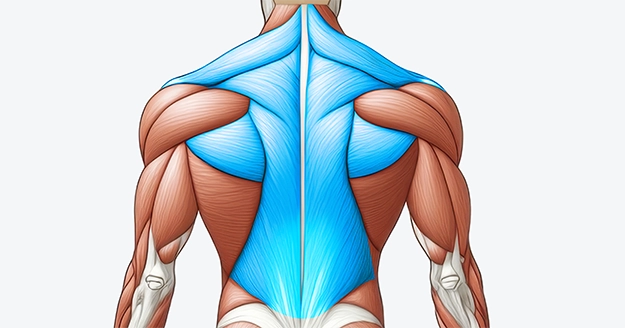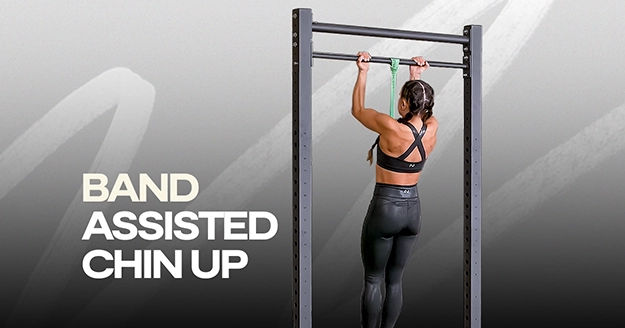Exercise Profile
Band-Assisted Chin-Up Overview
The band assisted chin up is an effective upper body exercise primarily targeting the back, and biceps. It’s an excellent way to build strength in pulling movements, especially for those working up to performing unassisted chin-ups.
For beginners, the assisted chin up with band reduces the amount of body weight lifted, allowing for proper form and gradual strength progression.
Chin ups band assisted can be integrated into your routine for building upper body pulling strength or as a stepping stone to mastering full chin-ups. They’re great for back or full-body workouts and can help improve overall upper body muscle development and endurance.

Band-Assisted Chin-Up Instructions
If you’re new to the exercise, following this band assisted chin up guide can help you learn proper form and technique while building strength safely.
Step 1: Tie one end of the band on the pull-up bar. Then, pull it through the other end and loop one foot inside the band. With your palms facing you, grab the bar.
Step 2: Engage your core, glutes, and thighs. Gently let your body hang until your arms are fully extended. Brace your chest and inhale.
Step 3: With control, pull your shoulder blades together and drive your elbows toward your hips. Breathe out as you pull yourself up until your chin passes the bar.
Step 4: Pause briefly. Then, slowly extend your arms to lower yourself. Maintain a slight bend in your arms.

Common Band-Assisted Chin-Up Variations
Chin-ups are a powerful upper body exercise, but you can modify them with different variations to make them more accessible, challenging, or to target different muscles. Aside from band assisted chin ups, here are other popular chin-up variations to add to your routine:
Band-Assisted Chin-Up Tips
- To ensure stability and control during the exercise, keep your core tight throughout. This helps prevent swinging and ensures you’re using your upper body muscles effectively.
- Pause at the top of the movement. Squeeze your shoulder blades.
- Take a deep breath as you prepare to pull yourself up. This helps brace your core and create tension for better stability.
- Breathe out slowly while pulling your chin above the bar. This controlled exhale helps you stay focused and maintain strength throughout the movement.
- Avoid relying too much on the band: Try not to “bounce” off the band. Use it for assistance, but actively pull yourself up with your back and biceps.
Band-Assisted Chin-Up Common Mistakes
- Leaning too far back: Leaning excessively during the pull can take the focus away from your target muscles.
- Improper grip: An incorrect or weak grip can stress your wrists or forearms. The bar should be across your palms, not across your fingers.
- Failing to engage your core: Not activating your core can lead to swaying or arching your back, which reduces control and efficiency.
Frequently Asked Questions
How many band-assisted chin-ups should I do a day?
It depends on your fitness level. Beginners may start with 2-3 sets of 5-8 reps, while intermediate or advanced individuals can aim for 3-4 sets of 8-12 reps.
How to choose the right resistance band?
Start with a thicker band for more assistance if you’re just beginning. As you gain strength, use thinner bands to reduce the assistance, eventually progressing to unassisted chin-ups.
How do I prevent swinging during the exercise?
By engaging your core and performing the exercise with control, you can help prevent swinging. Focus on pulling your body straight up and down without using momentum.
What are the benefits of a band-assisted chin-up?
Band-assisted chin-ups primarily target the back, and biceps. It also helps you build strength to do full unassisted chin-ups.
Post your post-workout selfies in IG and tag @trainestapp, #trainest, or DM them to us to get a shoutout on Trainest Stories!


